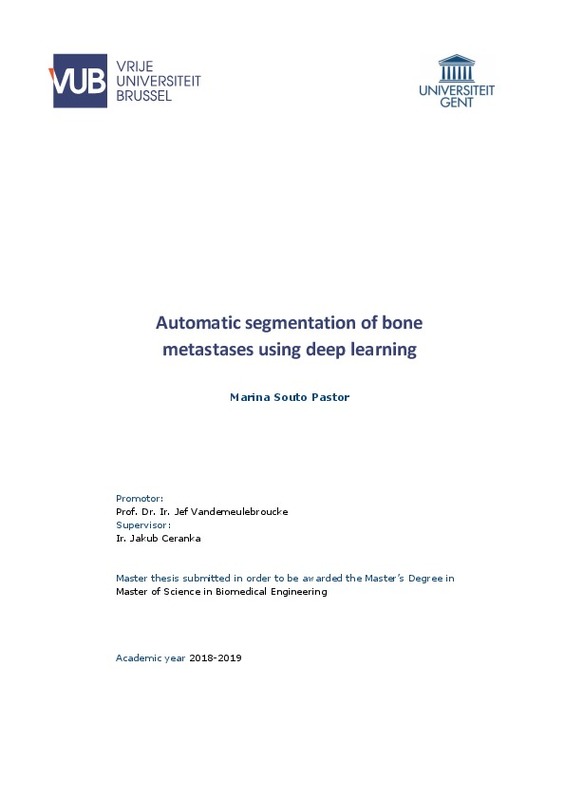JavaScript is disabled for your browser. Some features of this site may not work without it.
Buscar en RiuNet
Listar
Mi cuenta
Estadísticas
Ayuda RiuNet
Admin. UPV
Estudio de técnicas de deep learning para una segmentación automática de imágenes de resonancia magnética de metástasis óseas
Mostrar el registro sencillo del ítem
Ficheros en el ítem
| dc.contributor.advisor | Moratal Pérez, David
|
es_ES |
| dc.contributor.author | Souto Pastor, Marina
|
es_ES |
| dc.date.accessioned | 2020-04-13T23:08:39Z | |
| dc.date.available | 2020-04-13T23:08:39Z | |
| dc.date.created | 2019-09-30 | |
| dc.date.issued | 2020-04-14 | es_ES |
| dc.identifier.uri | http://hdl.handle.net/10251/140617 | |
| dc.description.abstract | [EN] Bone metastases are a common complication in some high incidence types of cancer, like prostate or breast cancer. The complications associated with bone metastases include bone pain, fractures and spinal cord compression. Most part of bone metastases are irreversible and treatments are focused on slowing the growth of the lesions. In the United States, 17% of the total direct medical cost was employed treating bone metastases. In order to improve the health of the patients and cut down medical costs, early detection is crucial. Some studies have shown that Whole-Body MRI has the potential to become the best method for diagnosis but there are still some difficulties left. One patient can have multiple bone metastases all over the skeleton in different sizes. This makes diagnosing bone metastases a tough task for the radiologists and because of the irregular shapes of the bone metastases, changes in size are also difficult to measure. The goal of this project is to provide an automatic tool for the segmentation of bone metastasis, making it easier for the clinicians to diagnose and to control the size of the present metastases. Using different modalities of MRI (T1 and B1000) and different patch sizes (16x16x16 and 32x32x32) a convolutional neural network (UNet) was trained. The segmentations predicted by each U-Net employing one modality and size, were later combined into one final segmentation. The best results achieved with this approach are the following: a correct detection of 37 bone metastases out a total of 100 with 67 false positives using k fold cross-validation and a dataset of 6 different patients with multiple acquisitions making a total of 100 lesions. | es_ES |
| dc.description.abstract | [ES] En este trabajo se investiga la capacidad de las redes neuronales, en concreto redes neuronales convolucionales (CNN), como una herramienta para la segmentación automática de metástasis óseas locales en imágenes multimodales de resonancia magnética. | es_ES |
| dc.language | Inglés | es_ES |
| dc.publisher | Universitat Politècnica de València | es_ES |
| dc.rights | Reconocimiento (by) | es_ES |
| dc.subject | Segmentación automática | es_ES |
| dc.subject | 3D CNN | es_ES |
| dc.subject | Metástasis óseas | es_ES |
| dc.subject | U-Net | es_ES |
| dc.subject | MRI | es_ES |
| dc.subject | Automatic segmentation | es_ES |
| dc.subject | Bone metastasis | es_ES |
| dc.subject.classification | TECNOLOGIA ELECTRONICA | es_ES |
| dc.subject.other | Máster Universitario en Ingeniería Biomédica-Màster Universitari en Enginyeria Biomèdica | es_ES |
| dc.title | Estudio de técnicas de deep learning para una segmentación automática de imágenes de resonancia magnética de metástasis óseas | es_ES |
| dc.type | Tesis de máster | es_ES |
| dc.rights.accessRights | Abierto | es_ES |
| dc.contributor.affiliation | Universitat Politècnica de València. Departamento de Ingeniería Electrónica - Departament d'Enginyeria Electrònica | es_ES |
| dc.contributor.affiliation | Universitat Politècnica de València. Escuela Técnica Superior de Ingenieros Industriales - Escola Tècnica Superior d'Enginyers Industrials | es_ES |
| dc.description.bibliographicCitation | Souto Pastor, M. (2019). Estudio de técnicas de deep learning para una segmentación automática de imágenes de resonancia magnética de metástasis óseas. http://hdl.handle.net/10251/140617 | es_ES |
| dc.description.accrualMethod | TFGM | es_ES |
| dc.relation.pasarela | TFGM\114701 | es_ES |
Este ítem aparece en la(s) siguiente(s) colección(ones)
-
ETSII - Trabajos académicos [9940]
Escuela Técnica Superior de Ingenieros Industriales






